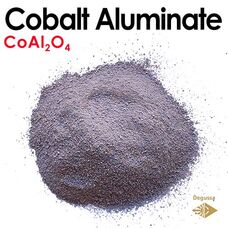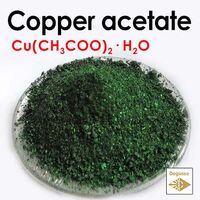What is cobalt aluminate? What is cobalt aluminate used for? What is the chemical formula for cobalt aluminate? Can Cobalt Aluminate substitute Cobalt Oxide
CoAl2O4
Cobalt(II) aluminate - Cobalt Blue cobalt(2+);oxido(oxo)alumane. Bright blue ceramic CoAl2O4 nanocrystals was prepared by sol-gel technique using aluminum nitrate, cobalt nitrates, diethylene glycol monoethyl ether, and citric acid were used as precursor materials.
The basic cobalt blue color, Pigment Blue 28, is produced by high-temperature calcination of cobalt (II) oxide (CoO) and aluminum oxide (Al2O4). The variations are produced by a partial substitution of the cobalt by chromium and zinc, either alone or in combination with each other. The result is a large variety of cobalt blue pigments that differ in their tinting strength or hues (reddish or greenish blue), depending on the exact chemical composition. The lighter-colored cobalt blue is prepared by addition of zinc (II) oxide to the ingredients used for the basic pigment, forming Pigment Blue 72. Blue-green hues are produced by introducing chromium (III) oxide, partially replacing the aluminum (III) oxide in the basic cobalt blue, forming Pigment Blue 36.
All of them form the crystalline modification of spinel during calcination. The spinels are a class of minerals that crystallize in the cubic (isometric) crystal system with the oxide anions arranged in a cubic close-packed lattice and the cations occupy some or all of the octahedral and tetrahedral sites in the lattice. Spinel minerals form octahedral crystals that are usually twinned. They have an imperfect octahedral cleavage and conchoidal fracture. The hardness of spinel minerals is around 8 (chalk has a hardness of 2-3), specific gravity is 3.5-4.1 and it is transparent to opaque with a vitreous to dull luster.
Cobalt Aluminate - Uses in Pottery - Pigment Blue 28
Cobalt Aluminate Blue Spinel, an inorganic pigment, is a reaction product of high temperature calcination in which Cobalt (II) Oxide and Aluminum (III) Oxide in varying amounts are homogeneously and ionically interdiffused to form a crystalline matrix of spinel. Its composition may include any one or a combination of the modifiers Li2O, MgO, SiO2, TiO2, or ZnO. Mason Stain for tinting ceramic glazes, slip, and clay. Mason Stains are fritted lead-free oxides. They are safe and dependable to use.
Mason Stains are combinations of oxides, fritted to insure uniformity of color and thus insure uniformity of results in firing. They can be used to color transparent or opaque glazes, underglazes, slips, engobes or clay bodies. Color results will vary according to glaze composition, firing temperature and kiln atmosphere. The quantity of stain used will vary between 1%-15% depending on the depth of color required. The stains may also be used effectively as colorants for direct brush decoration when mixed with water and a flux such as Ferro Frit.
Formula: CoAl2O4
Molecular Weight: 176.89 g/mol
Form: powder
CAS Number: 1345-16-0
Density: 4.3 g/cm³
Synonyms: Cobalt Blue Liquid, cobalt(II) aluminate, Cobalt aluminum oxide, Cobalt aluminum oxide, nanopowder
Cobalt aluminate Blue - cheap way to get amazing blue color
- Brand: Degussa
- Product Code: Oxide - Cobalt Aluminate - CoAl2O4
- SKU: CoAl2O4
- Availability: 990
-
0.99€
Available Options
Related Products
AMMONIUM NITRATE - What is ammonium nitrate and what is it used for
NH4NO3 AAmmonium nitrate (NH4NO3) is a chemical compound that consists of ammonium ions (NH4+) and nitrate ions (NO..
0.59€ 0.99€
Sodium tripolyphosphate - The Advantages in the Manufacture of Ceramics
Na5P3O10 Sodium triphosphate (STP), also sodium tripolyphosphate (STPP), or tripolyphosphate (TPP)) is an inorganic..
0.59€
PRUSSIAN BLUE - Ferric ferrocyanide, Iron hexacyanoferrate - A Journey into Berlin Blue: History, Chemistry, and Applications
Fe4[Fe(CN)6]3 Prussian Blue is a deep blue pigment that has been used in various applications, including art,..
1.59€ 1.99€
COPPER ACETATE - Exploring the Versatility of Cupric Acetate: Properties, Applications, and Uses - CUPRUM ACETICUM
Cu(CH3COO)2 Copper acetate has several uses:Catalyst in Organic Reactions: It is used as a catalyst in various orga..
0.99€
Tags: oxides










